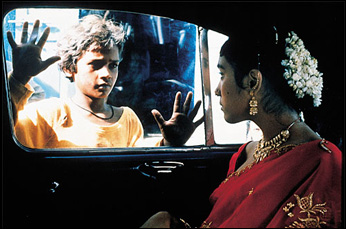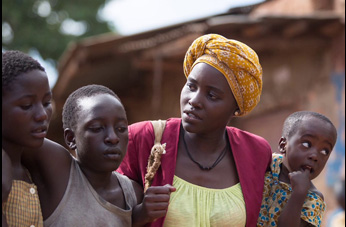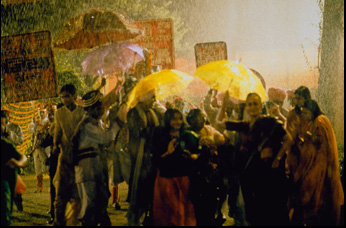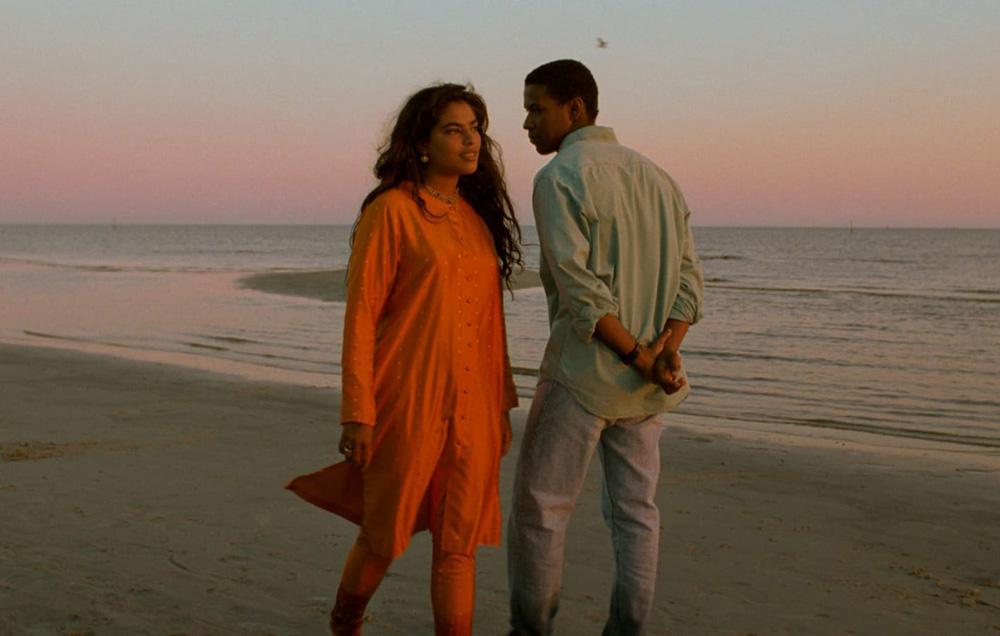“I love hands,” Mira Nair explained, giving as unexpected an answer as the question she received from Ava DuVernay during a trip to the ARRAY Campus in Los Angeles last fall, asked where she prefers to be on a film set when directing her actors, realizing from her narrative debut that standing behind the monitor was no place for her and if she could get as close to the actors as she would with her camera, that experience would transcend the screen. “I love how people reveal their life and their struggle through their hands and Shafiq [Syed], who was the center of ‘Salaam Bombay,’ every time he had to think, he’d put his hand to his ear and he would have a private moment of reverie. It was such a vulnerable, beautiful way to also see this rough, almost adult hand scarred by years of the street and yet this child with an 11-year-old face, it would move me to no end, so I would immediately use that.”
It was clear DuVernay was going to have a different conversation with Nair than the ones the “Selma” director knew from her own experience typically steered towards race and gender rather than the rare ability she has as a storyteller. Nair had made the trip specifically to ARRAY for her only in-person stop in L.A. for a retrospective screenings of “Monsoon Wedding” and “Mississippi Masala,” during what has been a much-deserved year-long celebration — the latter was recently released on a Criterion Collection Blu-ray and will soon enjoy another screening of its glorious new 4K restoration at the Academy Theater on June 2nd, while in-person tributes await in Toronto on June 7th at the TIFF Bell Lightbox and at this year’s Blackstar Film Festival in Philadelphia in August where Nair will be honored with the Luminary Award. But at ARRAY, DuVernay was keen just to talk shop.
“What do you know, just two ladies talking about craft?” DuVernay said, clearly delighted to get into the nitty gritty of the filmmaking process as was Nair, who remembered interviews in which she was asked where the best Indian restaurants were with playful contempt. (“Twenty years ago with ‘Monsoon Wedding,’ several questions like that, leading critics will ask me and I responded, “Bertolucci is outside, will you ask him where the best ham in Parma is?” she recalled.) There was some discussion of Nair’s unique perspective from growing up in Odisha (once known as Orissa) — a screening of “Love Story” had inspired her to apply to Harvard where it was set, though it was only when she got to America she began thinking about making films after planning to work in the theater — but the occasion of swapping stories with DuVernay allowed for a wide-ranging conversation that involved not only experiences from the set, but building their own filmmaking communities so that other artists wouldn’t have the face the same questions as they have.
Sitting at ARRAY where DuVernay has created a multifaceted studio to make cinema more multicultural on all fronts from exhibition to distribution to production, Nair was inspired to speak about the Maisha Film Lab, the initiative she began in 2005 to lift up voices from East Africa. Over the past 16 years, the school provided a free education to groups of 12 aspiring filmmakers from Tanzania, Kenya, Rwanda and Uganda. To Nair’s count, the lab has at least a thousand alums, 28 of whom have gone on to make features when her original hope was to have five with sustainable careers. (Not yet a director, the school’s most notable success story may be Lupita Nyong’o, who hadn’t acted before she was brought to Maisha by Nair when she was working for the director as a production coordinator, and was cast by one of the students.) Still, Nair needn’t look at IMDb pages to know what the lab has achieved when each student that’s passed through Maisha were encouraged to plant a sapling tree and it’s grown into a forest.
“The mantra of Maisha if we don’t tell our own stories, no one else will,” said Nair, who noted the program is now on pause to reimagine it in wake of the pandemic. “Of course, I added if they tell it, they will bolly It up, so you better know how to tell it.”
The inspiration for Maisha came from the same question that Nair has always asked herself —can art change the world? For the director, storytelling could be seen as a means of survival in her own life when she first sharpened her skills at the dinner table, having to compete with two older brothers for attention.
“From the get-go, I had to deserve my audience because if I spoke, the brothers would just tease me out of everything,” Nair recalled. So if I spoke at all and made a story, it had to be really good and the way to get the family’s attention is to be able to tell a crafted story and that that would make some sense and perhaps hopefully have some humor.”
Nair said her mother always believed she would somehow turn this ability into a professional calling, reminding her later of how she would go out jogging when she was 11 and ask all she could of her local milkman to find out more about his life. With a cinema in her rural town of Orissa that only played “Doctor Zhivago,” she wasn’t initially much interested in movies in general, and particularly narrative dramas, until well into her career, first working with radical playwrights in Calcutta for the stage and then in documentaries, studying under the legendary Ricky Leacock before returning to India as a professional filmmaker.
“I served as an editor to local filmmakers in India and I have felt the friends that reduce these larger political themes to didactic lectures that are less smart than they are, so I didn’t want to do it that way, but I did want to know because I come from the land of great inequity, which you cannot ignore,” said Nair. “In a way, Los Angeles, they shield you, but not in India, not in East Africa. In the street, you cannot forget that you have and they don’t have. You cannot. So that was the original inspiration and using cinema to actually reflect that question.”

“One of the early inspirations for “Salaam Bombay” was a traffic jam in Bombay and I had this long hand holding my taxicab and I looked down and it was just a kid who had a torso and arms and no legs on a makeshift platform,” Nair remembered. “He was holding onto my cab and the lights changed and he took the momentum of the taxi and then left the taxi and pirouetted on his own, like there was an audience and I thought “Oh my God.” This is the spirit of this. This is not begging and pleading and all that – that’s also there, but what I loved was this flamboyance and [this feeling of] I want to be a child, whether you give me a childhood or not, I’ll do it, and this is what I think I’ve tried to make in pretty much all my work is the desire to live, the desire to live fully and to grab it, to swallow life.”
No less than her mentor Leacock would tell Nair, “You take a character and you don’t know what the story will be, but you have your own questions and you form the story as it unfolds before you,” and she was inspired to begin casting nonprofessionals from “Salaam Bombay,” with the 11-year-old Shafiq Syed, on, often pairing them with the renowned actors in the world as her stature within the industry grew. For “Mississippi Masala,” that meant taking a chance on Sarita Chowdhury, a film theory student she had seen riding a bicycle in a picture with her flowing mane of hair, and pairing her with Denzel Washington or gathering an ensemble of novices around Bollywood royalty Naseeruddin Shah for “Monsoon Wedding” and watch them become some of the biggest stars in Indian cinema after the film was a hit. She remembered on “Queen of Katwe” how her former assistant Nyong’o may have arrived on set in Kampala as a recently crowned Oscar winner for her work in “12 Years a Slave,” but was quickly brought down to earth by the first-time actors who would be playing her children in the film.

If Nair delighted in creating such a humbling experience for Nyong’o, let it not be said she isn’t willing to put herself through the wringer herself, describing the making of “Monsoon Wedding” as the result of a challenge to make something out of only what resources she had around her. She recalled the inspiration of living in post-apartheid South Africa after the end of Mandela’s presidency and seeing a new generation begin to imagine a future for themselves that didn’t involve the segregation of the past, and from a workshop she had put together for 26 budding filmmakers living in the townships, where there was no electricity or public transport, she wondered if she could accomplish what she was asking of them.
“What I was trying to teach was can we make something out of nothing because actually the the opportunities in South Africa were actually much greater than in India where I had come [from] where we actually had nothing in terms of film or equipment or training,” Nair said. “That unlocking led me to ask myself, can I make something out of nothing now when I had made $12 or $15 million movies already? That was the original premise that made me think of ‘Monsoon Wedding,’ which is make it within one’s family, make it in a home that is your own.”
Nair could at least draw on her hard-won credibility, getting Shah, who she describes as “our DeNiro in India,” to come aboard the scrappy production and lining the walls of the Verma family’s home with exquisite art she borrowed from friends, but she planned a one-month shoot around her son’s school holiday — the fact it took place in monsoon season was happenstance – and brought out saris and family china from her own closets and pressed her mother into cooking for the crew. (“The great actors that are in the movie still say, ‘it was very, very nice to make your movie…but the okra!,” she laughed) After cobbling together a budget from a trip to Cannes where she charmed 18 investors with no script but her considerable charm, Nair asked Sabrina Dhawan, one of her students at Columbia where she was teaching at the time, to start working on a draft and while resources might’ve been limited, the freedom was rejuvenating.
“The idea was that no one would tell me what to do, that I could make it like we really lived,” said Nair. “You know, we can speak in four languages in one sentence, for instance. If you tell that to a distributor, they just hold up their heads and say, ‘Forget about it.’”

“We actually had many weeks of workshops with the actors and nonactors to create this family vibe and decorated this fantastic modernist house in the Delhi outskirts and we essentially lived there – blocked the whole film for a week before we started shooting because we only had 30 days to film what became a very complicated film,” Nair said. “So we shot eight pages a day, which you never do in movies, and the reason we could do it and keep the visual inventiveness and the style is it was actually utterly preplanned to look like it wasn’t planned at all.”
At this point, making movies comes much easier to Nair than to see that they have a proper release in the world, particularly when even her past work is at risk of disappearing. “Mississippi Masala” was thought to be lost when Nair was asked by the British Film Institute to show it and no prints were immediately located. Cinecom, the company that initially financed the film, had been sold repeatedly since 1990 and ultimately, the film belonged to a music company in Tennessee and a print was traced back to a basement in Nashville. (Since this conversation, Nair joined the advisory board of Missing Movies, a nonprofit dedicated to tracking down rights holders of indie films that may not even be aware of their ownership and getting the films back into public circulation.) While the actual elements were cleaned up for a new 4K restoration, Nair found upon a rewatch that the cross-cultural romance between an American carpet cleaner (Washington) and recently relocated Ugandan Indian (Choudhury) didn’t seem to have aged a day.
“It was a radical film in black/brown relationships at that time and I don’t think there’s been much progress made in 30 years, except there’s Kamala Harris, the embodiment of the child of Masala I like to think,” said Nair. “But we all can see the film again and be a part of this introduction because when I saw the film at the New York Film Festival, it’s still radical, it’s still timely and of course it’s still incredibly sexy — it’s an audacious film in which the politics in it are actually engaged in enjoyable fun, in the best sense of the word, so I was actually a little taken aback by the film that we made then and maybe we couldn’t even make today, actually.”
After noting that 2021 marked the 30th anniversary of “Masala” and the 20th for “Monsoon Wedding,” DuVernay spoke in admiration of Nair’s enduring career, pointing out that she’s “one of the women filmmakers around the globe who has made more than three feature films and when you realize how many female filmmakers have had careers where they can have these kind of landmarks, where there’s longevity, where there’s decade after decade and you see the craft change and mature and grow with them, it’s fabulous,” to which Nair could only laugh, “You all remind me that these are anniversaries. To be honest, I really live in the present, but someone [like] Lupita will write to me, “Five years now, ‘Queen of Katwe’” and it’s a little bit of a beautiful alarm.’”
When DuVernay mentioned her own dream for herself is to “Call action and cut with my cane,” making movies until the bitter end, she asked Nair whether she’d like to do the same. Nair didn’t want to imagine an end, but said what she loved about films was “it allows such an elasticity that you encompass the talent and craft of so many others and other mediums, say paintings or visual art or performance or a new way of even creating dramatic structure that can create a story” that she doesn’t believe she’ll ever lack for inspiration. As for what keeps her going now, Nair said it’s the same that it’s always been.
“For me, it became about entering worlds that I want to be in,” said Nair. “I want to be in ‘The Reluctant Fundamentalist,’ the world of what is a brown young man who loves America and becomes Mr. America — comes to Princeton, joins Wall Street, falls in love with a gorgeous American girl who comes from a blue stocking family — and then 9/11 happens and then suddenly he’s just a bloody Muslim in their eyes. That story, I’ve seen it all over in my life, but I hadn’t seen it on screen, so it’s like how to show the unseen, but show the unseen in a way I deeply know. [Then] in “The Namesake,” I really know what it is to be in Calcutta and what it is to be in New York alone, and I know what it’s like looking at the Queensborough Bridge and think you’re on the Howrah Bridge in Calcutta — the two worlds that cinema really lends itself to so poetically — I think literature can do justice to that limbo of two worlds in a way that cinema can, but doesn’t do it as effectively and I make films that I feel only I can make, only I should make. That’s the big criteria for me — not to do things that anyone can make and to make them in a way that is not only an education, that really takes you on a journey that you suddenly are on and then you hopefully see yourself in it, but you look at it a little differently after it.”




